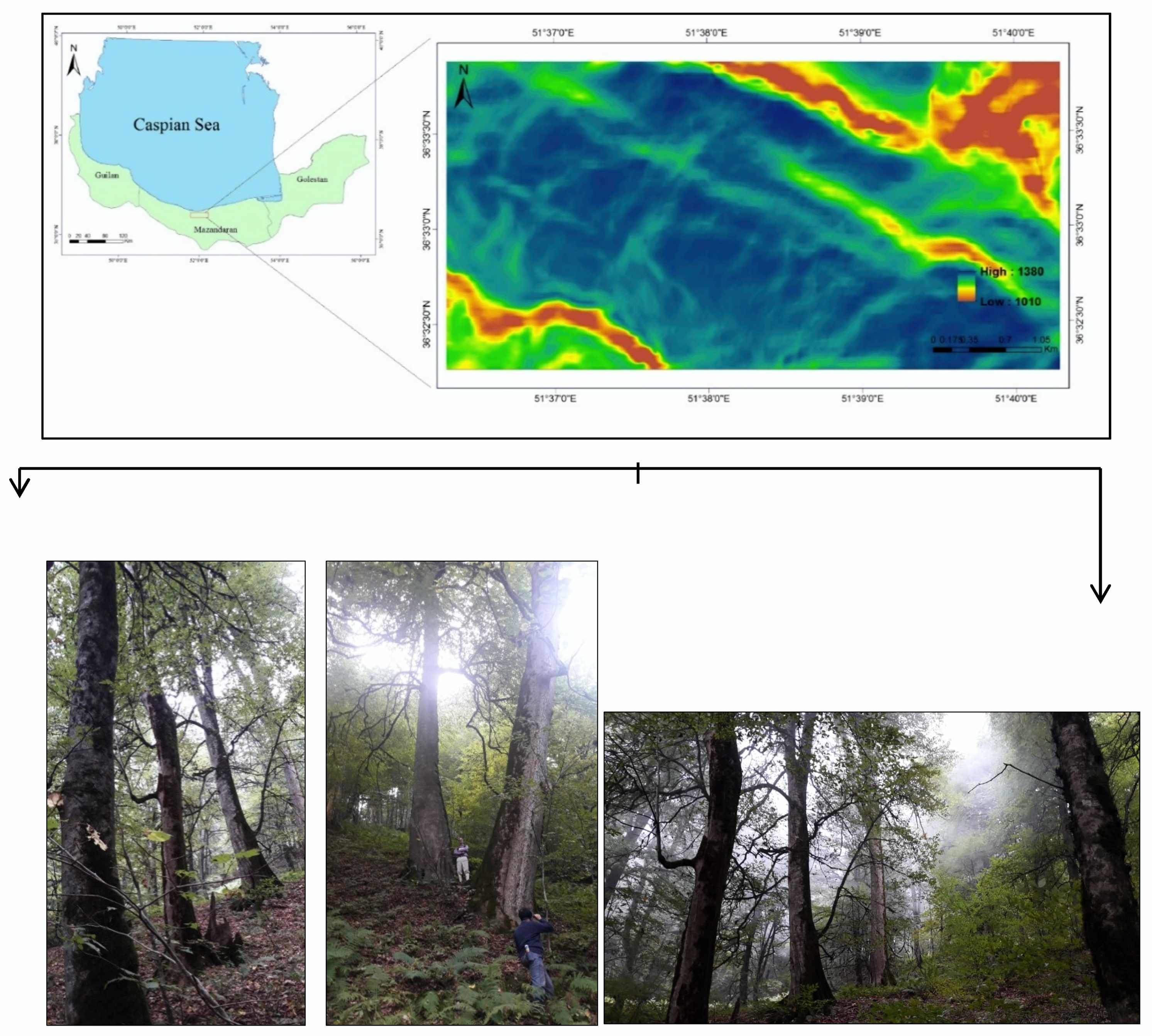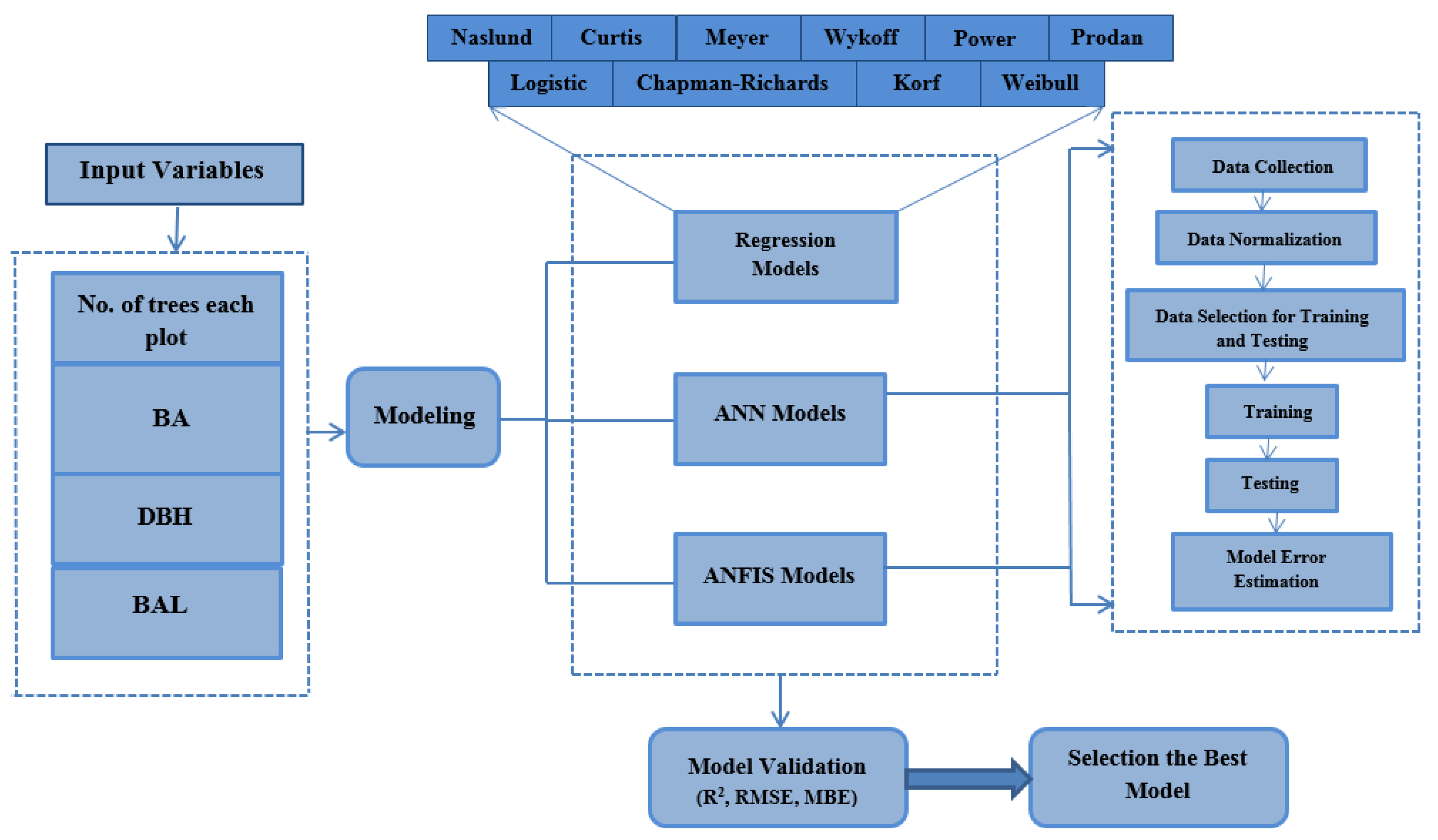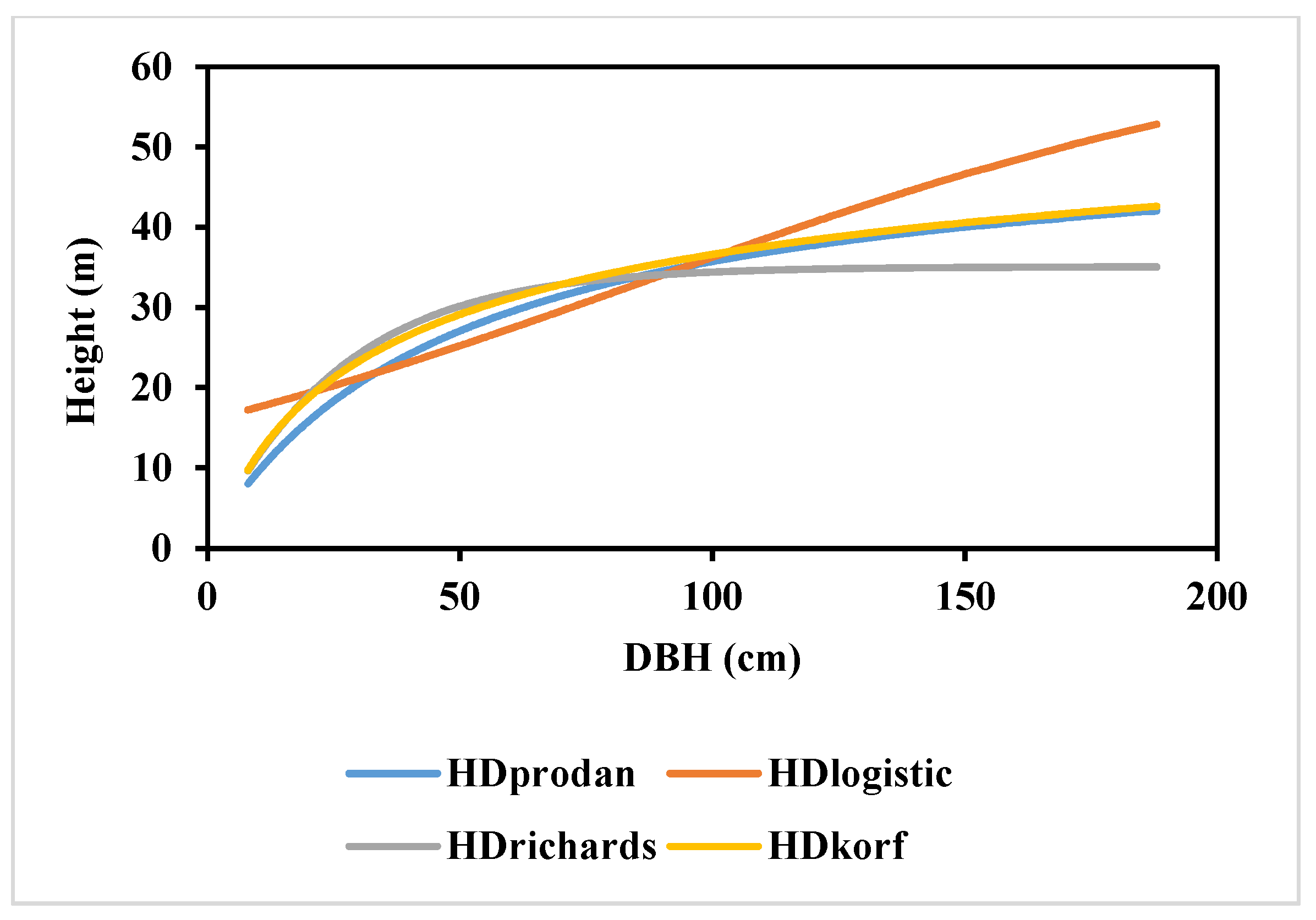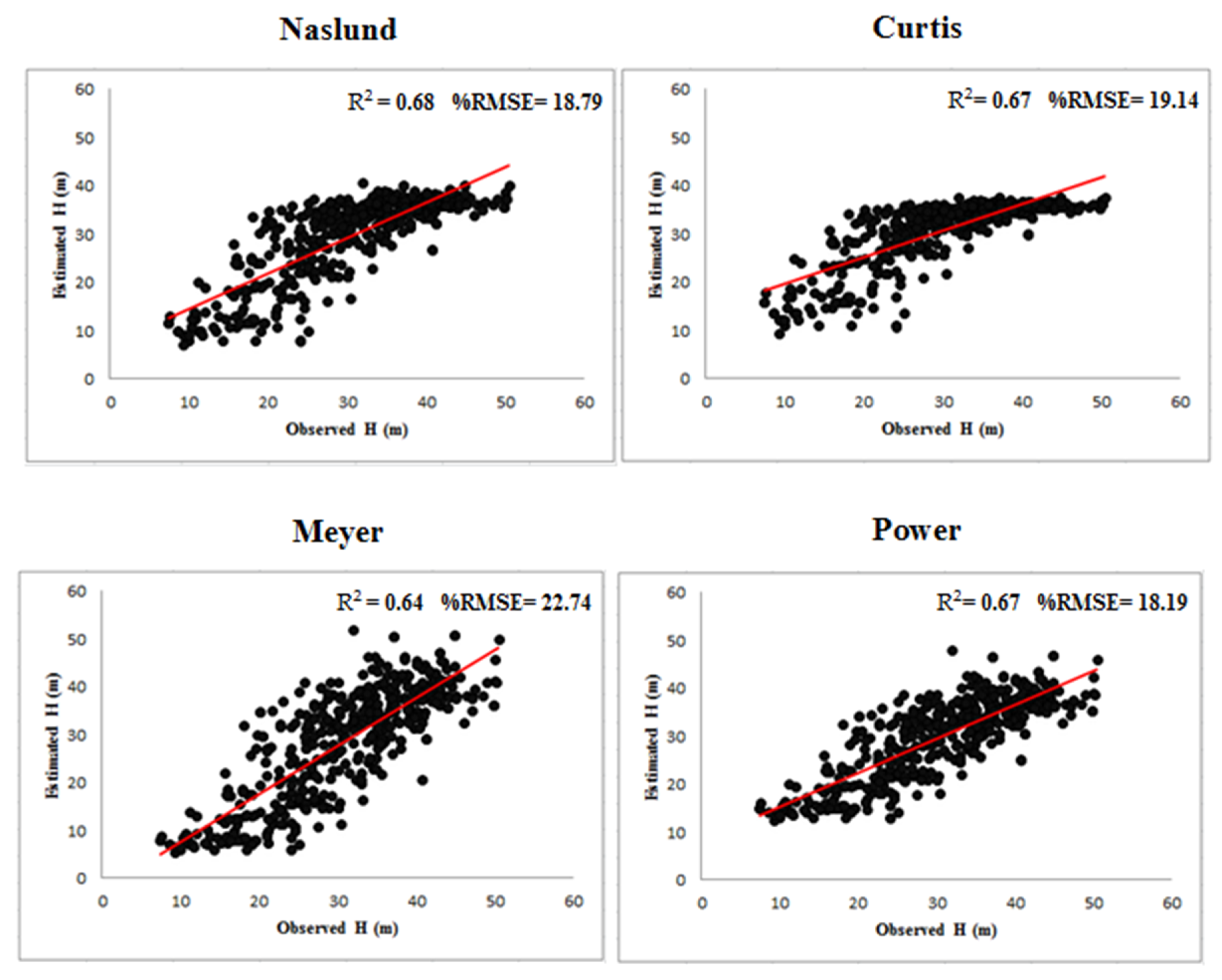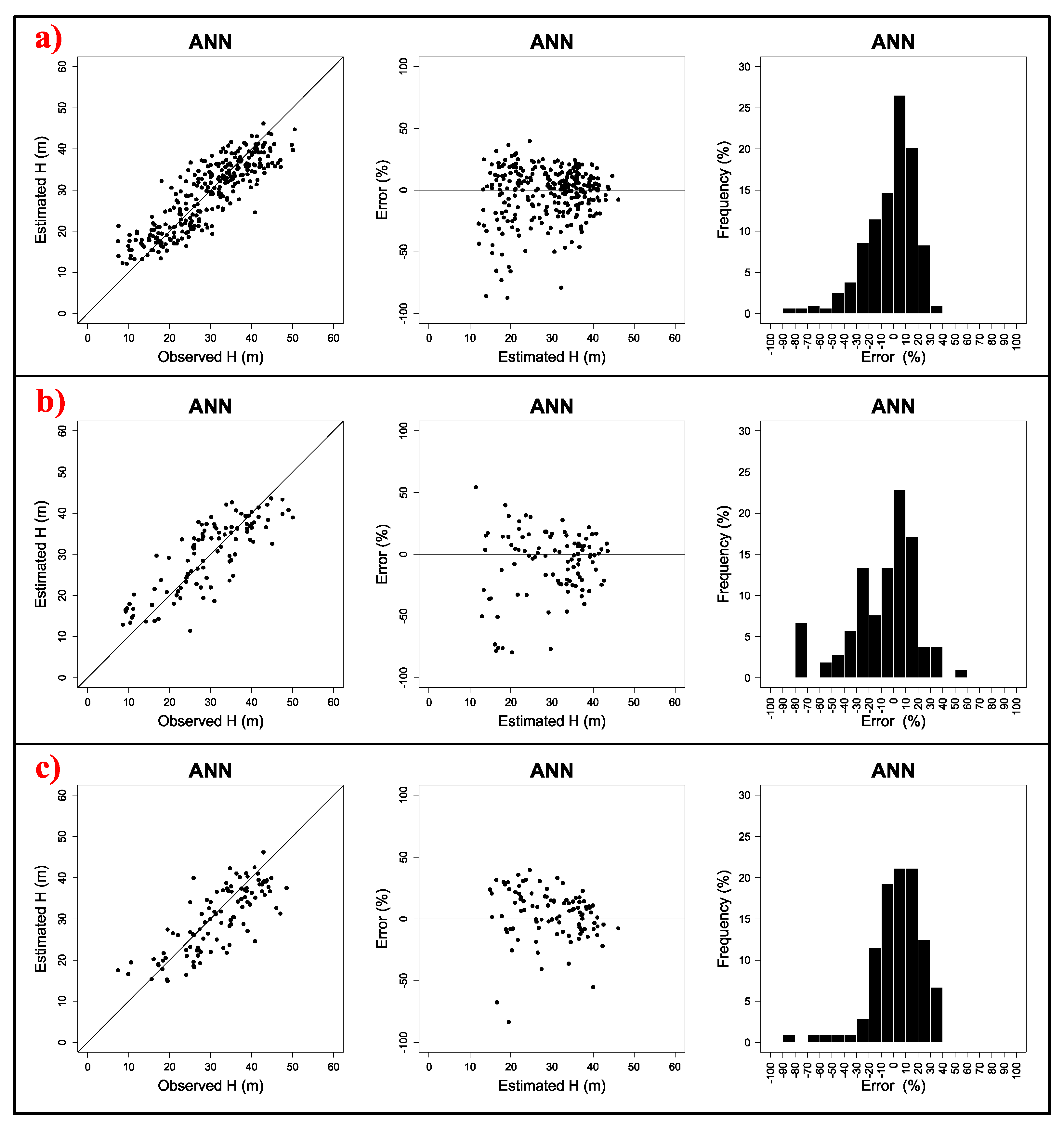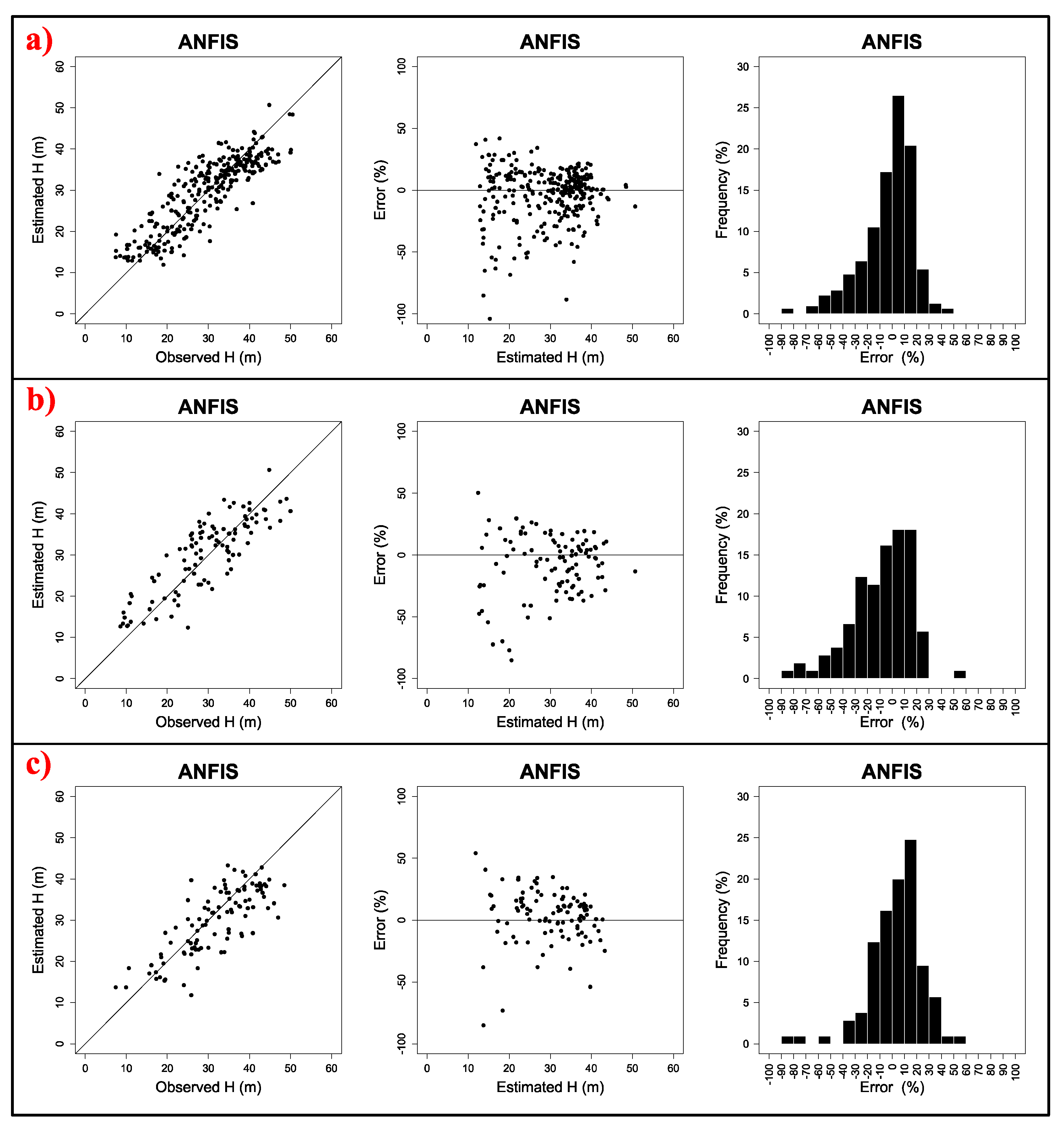1. Introduction
Hyrcanian forests, the only commercial forests in Iran, are considered complete biological communities. They have the highest degree of self-regulation and self-renewal among all natural ecosystems in Iran. Hyrcanian forests can be considered both as a starting point for efforts to maintain an ecological balance in nature, and as a model of irreplaceable pattern in forest science for the application of different methods of forestry [
1,
2,
3]. In concert with new management approaches for forest ecosystems, which can be based on multipurpose forestry goals, managers need accurate and precise diameter–height relationships to assess growth and production in the sustainable management of these resources [
4,
5]. Hence, diameter–height models are essential to better understand different relationships in nature, as well as to describe and study the differences and effects on forest ecosystem development [
4,
6,
7]. Further, the accuracy of such models is very important for the preparation of accurate volume tables and for the development of growth prediction models [
8]. For this reason, forest managers need to be informed of the connection between the diameters and heights of trees, and be able to accurately estimate the heights of trees using diameter at breast height (DBH). Oriental beech (
Fagus orientalis Lipsky), commonhornbeam (
Carpinus betulus L.), Caucasian alder (
Alnus subcordata C.A. Mey), velvetmaple (
Acer velutinum Boiss.), and large-leaved lime tree (
Tilia platyphyllos Scop.) are the main native species of the northern Hyrcanian forests of Iran, and are the most important and most valuable commercial species. Studying the height and diameter characteristics of these trees is very important and can provide valuable information for the management of these forests by future generations of society.
Total tree height is an important factor in forest management, as it is needed for determining many important forest-related indexes, such as growing stock volume, above-ground biomass, and carbon stock [
9]. While total tree height can be directly measured with analog devices (clinometers) or lasers, there are several methods for estimating total tree height, and they fall into three common categories: empirical, process, and hybrid models. Biological factors such as age and diameter are the main inputs of empirical regression models to estimate tree height [
10]. Process models can be created by including local indicators, such as precipitation, climate, and soil properties of the area, and other relevant factors to estimate total tree height. Hybrid models to estimate tree heights, through the integration of experimental models and process models, can also be created. These include mixed linear effects models and nonlinear mixed effects models, which may increase both accuracy and flexibility in modeling total tree height [
11].
The use of artificial intelligence (AI) methods to estimate forest yield has been highlighted in recent years. Artificial neural networks (ANNs) are a group of AI methods that can be used as an alternative to traditional modeling techniques such as regression models [
12], because they are more generalizable, and are less sensitive to noise and outliers. They can be more powerful than regression models when modeling nonlinear relationships unknown to modelers [
13]. Importantly, the implementation of AI techniques in forestry has generally been limited to the use of ANNs and other similar methods, such as fuzzy logic and adaptive neuro-fuzzy inference systems (ANFIS). Results of different studies have illustrated satisfactory results for the prediction of landslides, wildfires, and forest road network suitability [
14,
15,
16]. However, the use of ANNs to address nonlinear growth and yield problems has also become a very important issue [
17]. These types of models are able to address problems with nonlinear relationships between model parameters, and they are not restricted by the assumptions of empirical models [
8,
18]. An ANFIS is a fuzzy system with a parallel structure, and neural network learning algorithms are used to adjust the fuzzy system parameters [
13]. Although the use of ANFIS in many fields still is in early stages, in recent years good results have been realized when applying these methods to some forestry problems [
19,
20,
21].
Different models of height and diameter relationships have been presented in the literature. For example, Özçelik et al. [
8] modeled height–diameter relationships in southwestern Turkey using empirical models and neural networks. Their results showed that neural network models may be a good alternative to other methods for estimating tree heights. Ahmadi et al. [
22] modeled height–diameter relationships in the educational and research forest of Tarbiat Modares University using Weibull, Schnute, and Richards forms of regression, and found that Richards’ model performed the best due to its greater efficiency. Bayat et al. [
23] used diameter and height models to obtain the height of
Fagus orientalis in the Gorazbon district of the Kheiroud educational research forest of Iran, and showed that the Prodan model had more acceptable results than others examined. Vieira et al. [
13] used empirical models, ANNs, and ANFIS models to obtain the diameters and heights of trees of eucalyptus. They concluded that the ANN and the ANFIS models had greater accuracy than empirical models in diameter and height estimation. Nguyen Thanh et al. [
24] examined the usefulness of nonlinear equations and ANN models for describing height–diameter relationships in three diverse stand densities of a Korean pine plantation, and found that while all models performed well in describing height–diameter relationships, ANN models could decrease the RMSE the greatest. Zhou et al. [
11] estimated DBH in a forest area in China using multivariate linear regression and generalized regression neural network models, and found that the latter provided better results with stronger generalizability.
Generally, the above studies on the effectiveness of different height–diameter models indicated that results can vary for different habitats and species, and even in different conditions, such as different stand densities and relative positions of trees. The purpose of this paper is to examine the quality of results produced by estimating total tree height from DBH in Hyrcanian forests, using ANN and ANFIS models, so that the advantages and disadvantages of these methods can be compared against more traditional empirical models. Further, we hope to find an accurate and appropriate method for predicting tree heights for the most important and economically valuable species in the forests of northern Iran.
4. Discussion
All modeling methods that predict forest performance, such as regression models and artificial intelligence models, have their own strengths and weaknesses. Although traditional regression models are capable of providing specific formulas, and these may make it easier to understand the relationships between variables in these models, these models have many limitations, including being independent of the range of statistical assumptions, such as a normal distribution of data, independence of variables, and so on [
18,
49,
50]. One of the advantages of artificial intelligence techniques in stubborn modeling is that in many cases they do not have the same limitations of empirical models. For example, some assumptions (data normality and others) can affect the quality of empirical models. Other advantages of artificial intelligence techniques are the ability to work with qualitative variables and the relative accuracy and precision of these models [
13], which are often well reported in predicting tree heights. According to our results (
Table 7) artificial intelligence techniques had lower errors and more accurate estimations of tree heights in the study area, which is in line with the results of other studies [
13,
51,
52,
53,
54,
55].
The use of artificial intelligence techniques for forestry issues has become more and more popular recently, but is often limited to ANNs; other techniques such as ANFIS and fuzzy logic also have great potential for many forest modeling [
13,
56]. A
t-test was performed to compare the results of R
2 and RMSE, and according to our results (
p ≥ 0.005), there was no significant difference between the accuracies of ANN and ANFIS models in estimating tree heights in the study area. This finding is consistent with the results of Vieira et al. [
13], which concluded that artificial intelligence methods, including ANN and ANFIS models, can be of value for these purposes. In a study of the relationship between the diameters and heights of eucalyptus trees, Silva et al. [
51] compared fuzzy logic and neuro-fuzzy models with classical mathematical models and concluded that neuro-fuzzy models had the highest accuracy and precision in predicting eucalyptus tree heights.
Our results complement prior research in this area. For example, Leite et al. [
53] Diamantopoulou and Özçelik [
55] used six nonlinear regression models as well as the GRNN (generalized regression neural network) method to estimate tree heights in the western Mediterranean Region Forests of Turkey. Consistent with the results of this study, validation statistics of their models showed that the GRNN model has both higher and lower error rates than other models. They attribute this to the ability to model nonlinear relationships to predict tree heights. Bayat et al. [
18] used regression and ANN to predict the probability of tree survival in the Hyrcanian forests. They concluded based on model validation statistics, that ANN models were more accurate at predicting probability of survival and determining environmental affecting factors. These results are in line with the results of the present study. Zhou et al. [
11] also reached a similar conclusion, and like the results of this study, they also concluded that the GRNN model had higher accuracy than the regression models in estimating DBH in the Zhejiang province in China. Lee et al. [
57] used new three machine learning techniques, including support vector regression (SVR), modified regression trees (RT), and a random forest (RF) in South Korea to predict the heights of forest stands, and concluded that these three models were capable of estimating the height of stands well, and the estimates of these three models were not statistically significant. Finally, Bourque et al. [
4] in Kheyrud forest used genetic programming to determine the relationship between height and diameter in beech forest and select the most environmental variables. In these studies, they proved the capability of AI approaches for prediction. Despite the differences in the types of neural network or artificial intelligence techniques used in all of these studies, or in the numbers of and types of model inputs, all of them are consistent with this research in illustrating the superiority of neural network and artificial intelligence methods over regression models.
To model the diameters and heights of
Beech species in the northern forests of Iran, several different studies have been carried out, all of which used only nonlinear empirical models. Ahmadi et al. [
22] used nineteen linear and eight nonlinear models for beech forest-type data and concluded these models could predict 70–76 percent of the variation in the dependent variable; among them Schnute, Weibull, and Richards models best predicted heights. Alijani et al. [
58] used three diameter-height empirical models for beech species in unmanaged Kheyrud forests in northern Iran in three different successive stages. The results of this study indicate the suitability of relative function and Weibull models at early stages of forest development; the modified exponential at maturity; and Gompertz and Richards during the decay stage. Hamidi et al. [
59] studied the diameter and height models of beech species in uneven-aged forest of northern Iran, and concluded that the Korf, Ratkowsky, Naslund, and Weibull models have good ability to accurately estimate beech tree heights. Therefore, nonlinear empirical models have often been used to investigate suitable models of beech height prediction in northern forests of Iran. However, the present study is unique in applying artificial intelligence methods to this purpose, which showed that ANN and ANFIS models are more capable of predicting the heights of beech species in northern Iran.
